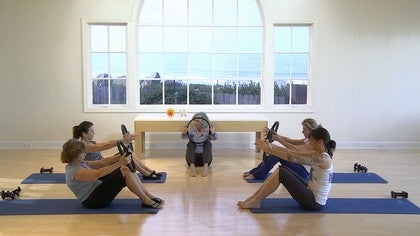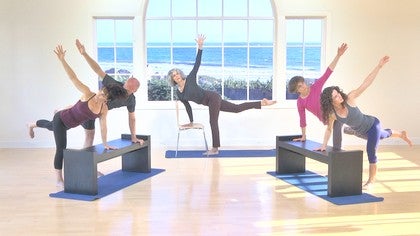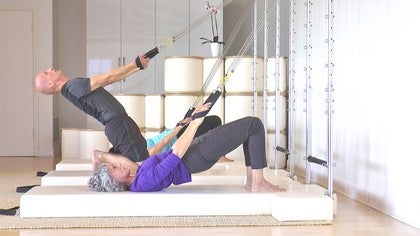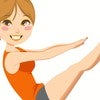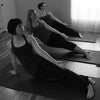Description
About This Video
Transcript
Read Full Transcript
Well. Hi and welcome back. Uh, my name is Wendy Lil Arbuckle and I'm just thrilled to be here with you all. I, um, am going to be guiding you today in a, what we'll call an embodied math class. So what I mean by that is that often, um, as teachers we tend to tell people what to do, but how much can we, what is really embodiment? What does it mean to be embodied? How do we, how do we get in touch with how we can move, which is more energizing? How do we, I see, I think of energizing rather than exercising.
So we're really looking from a place of what we call 10 Segretti, which is outer body, inner body. How do they relate to one another? How does my foot relate to my hand? How does my foot relate to my head? How does my head relate to my foot? So whether I'm moving from my head or moving from my tail and my foot, they're connected. So that's what this is all about.
This is how the body thinks. Doesn't think bicep dries up abdominals. So I'm never going to be telling you to pull your abs in. Your abdominals are going to be toning out of the way you're using your body because the body's deep intelligence is what we're interested in. Practicing and breath is going to be major player, major players. So place your hands on right at your ribs and just see our little breathing ball.
Just allow your inhale to happen. Allow your back to open, allow your ribs to open. And then as you exhale, allow the shoulder blades to release. And mutton just melt down your back. And notice how everything, the shoulder blades, that deep ribs melt toward your internal naval, your deep belly. It's naturally happening. You don't have to pull it in. It's just what's happening that we're getting in touch with, which is so beautiful.
So the distinction that I'll be teaching from his effort with ease, what's just enough effort? So I'm constantly going to be asking you, what can you let go of, which is a variant we don't usually ask ourselves that question. We should. We usually think, what can I do more of? But what can I let go of as I allow gravity to support me allowing. So as you're standing right now, what do we mean by that? What is gravity supporting us? Yeah, we know we're standing, but are we really partnering with gravity? The way to feel that is, notice if anything's locking out while you're standing.
Are Your knees locked or your hips locked? You feel like you're holding. Where can you be over your feet forward, back, side side. That begins to allow your joints. Think of a camera aperture. How does your ankle joint, your knee joint, your hip joint? How do they open so that you feel just like you're being held, you feel supported and allowing the floor.
We're touching the floor, feel the texture of the floor, feel the whole foot in relationship to the floor. So we do a whole another piece. Do the mat work on the wall. And I began teaching that about 12 years ago and it's just an incredible way of getting feedback from the, from close chain support. Do the same thing on the reformer.
If the footwork is actually about allowing gravity to support you, that's very different than pushing. First of all, you yield. It's our first sense, the first sense we develop in the womb. It's our vestibular sense. How can I allow myself to be held by gravity? Okay, so a couple things that you'll need for this mat class are a magic circle.
Wonderful little apparatus. And uh, everybody has either three pound weights or two a two pound weights. You can get a little heavier in your hands because the idea is to notice how support through the hand allows the shoulder blade to drop down, allows the tailbone to release, allows the feet to become more heavy, so we're calling that down the back, the shoulder blade, sit bone tailbone into the tripod of the foot. The down gives me lift natural, lift up the front inner ankle. Lift your toes as you're standing without joints tightening and just notice how you automatically turn on the lift of the inner ankle, the inner thigh, the front of the pelvic floor. It's like just that tiny little bit of stop the urine flow tiny bit so you're not squeezing your glutes at all, but you're turning on the front of the pelvic floor, which then creates lift through the front of the spine to the inner ear, inner ear up soft eyes.
I know these are a lot of things, a lot of things to be in present too, but what I promise you is then it's just, it's not something you have to remember. It's something your body knows that often we don't get in touch with and then it just becomes the way it is because it's not me making this up. It's something I've developed within my own way of being and teaching that I've gotten in touch with with is how we function. So we want to be working out in the way that we function. That was powerful. Then we truly become, which Joe's applaud. He's envisioned, which is self healing. Beautiful.
So let's begin with your magic circle. So come to the front of your mat and just press just enough. What's just enough to allow your inhale, exhale. And as you press in so small, what's just enough to get your shoulder blades to talk to your deep belly and your chest to widen. You see how if you pushed too much, suddenly you're in your neck and shoulders, right? So how does the down the back talk to the up the front? That's it. What's just enough effort? Yes.
Feel how the breath is the great mediator. The breath is what moves us and what we're wanting to feel is how our mind gets connected with breath and body. Usually the mind is dragging us all over the place. Who should I be? How should I be like I wish I was like this. If only I could be different, what should I be doing? But when we get in touch with the magnificence of who we are and the beauty of who we are, we begin to harvest. We're creating a garden, a way of being with ourselves.
It's so generous and then we feed other people with that spaciousness. Wonderful. Now put your hand inside and press out what's just enough cause you press out once again as you press, just notice heavy elbows, chest wide. What's just enough down the back showed a blade, sit bone tailbone into the tripod of the foot. Lift your toes and as you feel the down, notice how the lift is natural. It's just a lift.
That's like a rebound that happens called ground reaction force and it's gravity is partner and we're getting in touch with that and we're calling it down the back up the front.
So why we pressing in? Pressing out? Because we want to get in touch with the outer body, the power of the periphery. How ladder reality gives us medial. It's relationship. This is how the body thinks inside. Outside. So from here begin your squat is you press with just enough to open up your hips, open them up, widen, spread your toes as you spread your toes and sit only goes so far that you can really feel the widening of your feet. And then press down. Stand up.
That's it. How are you creating space so that your back body is releasing down, your front body is floating up. How are you creating glide, glide between the back and the front body? How is that opening up? How does that open up your hips and then press down to come up? Beautiful. Let's do that again. We're progressingly moving toward the mat. You're going to be going down and yeah, this is something you want to build. So it isn't like a pass fail. It's more like, what do I need here? What? What's, what's happening?
What can I develop more of as I play with this and concepts. So that's what we're doing. We're allowing, we're in bio intelligence, which is very different than bio mechanics. Biomechanics is the right wrong. Bio intelligence is a process oriented way of being with ourselves is never wrong. Keep going, keep going down. Keep going down. Now keep reaching forward. Forward, forward. Beautiful. Y'all great. Great, great, great. That's it. That's it. Feel it.
Now from there release and from there just begin to occur. I'll feel your feet. Feel your feet. Feel your feet as you find your waterfall. How is the waterfall releasing the down, which gives you up? Yes. Yes. Beautiful. That's it. Right?
And now from there, allow your inhale. And as you exhale, curl forward into your rib hinge. Feel the waterfall, the down. Great. Now, right there, place the power circle right behind your head at your occiput. Allow your head to rest heavy head like you've got your head in your hands. Now from there, allow your inhale and as you exhale and feel the, you might even play with this. Are you feeling? Yeah. Play with that feeling.
Yeah. Great. Cause the feeling you're going for is how can the back of your arm relate to your shoulder blade to deep belly? How can you feel the down give you lift. Keep playing with that. You want to get this feeling of inner ear coming up as the waterfall releases down and that creates glide in the body.
It also creates internal lift. You begin to talk to your feet, right? So find that internal place. Yes. Beautiful. And as soon as you feel it begin to feel as you lift your toes, feel the lift. How the leg wants to come toward that inner ear, the inner ankle to inner ear. They're related to one another. Find that float. How does the float? It gets you way out of your hip flexors and gets you into the release of the spine down the tail releasing down, which creates internal lift to the front of the spine.
Beautiful. And just play with that. Each side. Feel that? Yes, that's it. Feel the release down as you find the leg. Get connected to the spine. How does it become internally connected all the way up to the inner ear? Yes. Fabulous. This time, as you bring one up, keep it up and then float the other up to keep them both up. That's it. Yes. Beautiful. Stay right there.
Release the circle down. Reach your arms long by your side. Walk your hands along the Mat. Keep reaching down along the mat right now. Keep asking that down the back. Keep asking the down the back to bring you forward. Stay forward. Yes. Now from that place, begin to pump your arms from the back of your arm rather than going up.
Go down, down, down, down, down. Have your arm get heavy into your shoulder blade to deep belly. Yes. Feel the back of your own. Feel the bones get heavy. Yes. The chest is open, the neck is long. That's it. Gorgeous. And then one leg floats up. Stay forward. That's it.
Stay forward. Feel the hover. Feel the widening of your back. Yes. And then that one bends in the other extends. How does the inner ear lifting up create the reach of the foot. Yeah. How does the lift of the ankle, the inner ankle, inner thigh, internal belly to inner ear. How does that create more reach through the foot?
How do we feel? The directional spaciousness of the body. Beautiful. Yes. And then bring both knees in and lie back down. Gorgeous. Yeah. Hold your knees and rock side to side knees one way. Had the other way. Fabulous. Good. Take your weights.
So roll up legs are extended long, right? Get in touch with that, reaching down through the feet, lifting up through the inner ear. So find that down, the back, up the front sensation. And from here, just begin to extend your arms from your waterfall. Feel the shoulder blades releasing down. As you feel the inner ear lift in the other direction. The waterfall down the back is going to curl your head. You will feel the relationship, right?
Feel how there's a deep relationship in your body. As you float your arms right now, soften your feel how the softening of your knees gets you deeper into the lower. So as the softening of your elbows gets you into a softening of the upper. So as so you get the softening along the front of the diaphragm, which is right where the upper so as is the roots of the diaphragm right there rather than hardening. We want to soften and widen. That's it. Yes. And keep allowing the waterfall down your back as you curl.
Keep allowing the waterfall. Yes. Right. Stay in it. Stay in it. Don't compromise it. Feel the weight. Give you lift. That's it. That is beautiful. Yeah. And I find your hover hovering over right. And then from there, begin to curl back by floating the inner ear and releasing your tail.
As you release your tail, you keep the inner ear float. Notice how they talk to on another inner ear floats up. Tail releases towards your feet. Yes. Less and less tension. Fabulous. That was gorgeous. Gorgeous y'all. Yeah, right. Let's do that again. Feel it for yourself. What's happening is you're embodying an understanding of roll-up.
How do I lift naturally? How does this happen naturally without tightening my abdominals? How does my back Wyden? How does my chest open? How does my neck lengthen? How does, how does my arm release and float? And lengthen, which gives me more lift. How do I get heavy bones? How does the weight down allow me to feel? Float?
Yes. Yes. Fabulous. Also noticing that the weight in the hands really opens up the dome of the hand, creates an opening of the armpit. Creates a widening of the chest. Yes. And this time as you come back down, you'll stay down. Yes. Fabulous. Beautiful. So these are concepts that you'll take into what you're doing and you'll feel how once you get, they get more grounded, you'll be able to move quicker with them.
So right now we're grounding them and we're planting the seeds. Very good. And now from there, float your right knee in. Hole behind your side. Let go of the weights. Just hole behind your right thigh. Now, right here, stand on that left leg. Press the thigh into your hands. From your shoulder blade to belly.
Press the thigh away from you. Press it away. So you straighten your arms from the waterfall. That's it. Yes. Now allow your thigh bone to drop into the socket. Allow it to drop. Allow that right hip to get heavy. Allow the inhale. Exhale, straighten your as you straighten your leg. Come from a heavy hip.
Keep the heavy hip. As you inhale, softening the knee. Don't bend it really big. Just soften it. Inhale, feel it. Ground your hip more. And then from the grounded hip, you straighten your leg. How can this become, not a leg exercise, but rather a spinal exercise? How does the whole foot, the whole leg relate to the whole spine?
How does your right foot connect with your inner ear on the right? Yeah, that's right. How does the right hip relate to the left foot standing so you're not hiking your hip, you're feeling yes. You're releasing that hip down, which creates more lift through the left belly. How do you find that internal lift? That's it. And allow the grounding of the thigh bone in the socket.
Yes and great. Good. This kind of keep the legs straight. Circle your foot. Circle it around from that heavy hip. From that spinal support. Yes. Go the other way. Circling around.
Good point in flex moving through. Heel ball, toe, toe ball, heel, moving through the whole foot. Wonderful. Then send that leg away from you, send it away, press into your arms, press away, and begin to lift your head. How do you curl up? How does a leg become a weight? How does it become just like the weight? So walk up that leg, hand over hand. Walk up that leg and send that leg away. Send it away. Never lose your down.
Keep the down the back. Yes. Keep the down in the back as you walk up. Feel that down the back. Excellent. Excellent. That's it. That's it. And as you go down, reach that leg toward the center of the room. Reach it away and press the leg into your hands. As you reach that leg away, how does the down give you lift? Yes. Stay in the down, the back, up the front. As you curl down, right? Press that leg away from you.
See, you're asking the body, you're asking the leg to get deeply connected. Moving beyond, just stuck in the hip socket. How does it get fascially connected through the whole body. Send that leg away from you. That's it. That was beautiful. That's it. Right? And then from there, feel the lift and curl as you send that leg away, right? Yes.
Yes. Good. Right? And this time, as you come all the way down, stay down, right. Arms long by your side. Yes. And then from there, you circle that leg. Take it across the body. Inhale, exhale, and bring it in, right? Feel how the sit bone stays long as the leg comes in. That's right. Inhale. Exhale. How does that leg get connected to your spine?
How is it connected to breath? That's it. Inhale. Exhale. Last one, and reverse down across your body and come back in. Release that right. Sit Bone towards your left heel. The right sit bone stays long. Oh, nice. That's it. That's it. The hip stays long as the leg moves. That's it. Yes.
And beautiful. Bend that knee. Keep that hip long. Straighten that leg. Other side. Wonderful. Keep the lifts that bone reaching long toward the right heel as the knee comes in. Right. You're keeping the length and the width across that side. Right now, as you press that leg into your hands, find your shoulder blade to deep belly. That's it.
Yes. Feel the hip grounded. Inhale, exhale. Straighten your leg from a grounded hip. That's it. Inhale, soften. Exhale, straighten. Hip goes down as the foot goes up. That's it. Yeah. Only then notice if you over bend the knee, you get into the knee rather than into the heavy hip. Keep the focus on heavy hip. Yes.
So the softening of the knee grounds your hip takes you into a heavy hip and the heavy hip gives you a deeper, more, a deeper ability to get into the synergistic relationship between tight muscles. So you'll actually find that you'll get more hamstring stretch by not over bending the knee. Yes. Now hip stays heavy as you straighten and from there you circle circle around, just your foot. Just the foot, right from a heavy hip. There we go. Good. And circle the other way. Circling around. Well done. Yes.
And then point and flex. Very good. Yeah. Moving through the whole foot. That's it. And then you send that leg away from you and you walk up that leg. How does the down give you lift? How do you feel the release of the shoulder blades?
The drop of the spine. How does the waterfall of the spine release down, which gives us lift? How does the leg lift as we don't lose our width and length? We want dimension, not just length. We want fullness. How does breadth give us dimension?
How does that let fit bone reached towards your right foot? Yeah, waterfall down. That's it. Keeping that heavy as you curl. Right? Beautiful. Do you see how that's getting deeper? Amazing. It's amazing. I know because you're amazing.
That's what we're doing. We are amazing and we're discovering that. Yeah. We are not machines to be trained and fixed. We are deeply intelligent organisms and it's time we moved like it. Yeah.
Inhale, exhale. That's right. Keep the SIP on. Long as a lead comes in. Excellent. That's it. And reverse down across your body and come back in. Right. Put your hand on your right belly and seal. How the lift of the right belly creates the length through the left hip.
How are you creating lift through the suspender? How are you lifting the suspender on that right side to drop that left hip? You see there's your up the front giving you down the back on the other side. Yes. So cool. It's so cool. Yeah. Your body just goes, oh yeah. That's what all I did. That's what you want, right? Good. Good.
And then from there, roll right up to sitting. Coming up. Good. Yeah. Now from here, bring your knees in. Rolling like a ball. No, we're going to do it in a particular way. So you're going to do your traditional rolling like a ball, and you've got a feeling that I may kill myself if I try to do what I want to do right here. All right. Yes. Let me use this map right here and I'll show you. Beautiful. Thank you.
Yeah, so we're basically, we're gonna do, we're gonna curl, find that internal lift and we roll. Inhale, exhale. We're gonna do a few of those, but then we're going to hold the heels and feel the lateral feel how I'm rolling over, around and up, over, around and up. Over around and up. It is so fun. Saturday morning party, Saturday morning cartoons. Exactly. How do we become our own helm entertainment center.
Yeah, exactly. Exactly. Demo. So lateral, lateral to medial. And what you're going to notice, what you're going to notice is one's going to be easier. And now the, and first of all it's going to feel really odd at first. So go to do your traditional rolling like a ball. Feel that, just feel the, feel the front back. Feel the front back. Feel the up down.
Feel that relationship.
And so just know you're going to play with, you're playing with that grounding and that release. And then let yourself roll to one side. Yeah. Both going the same direction. Otherwise you'll crash into one another. So just go, yeah, you're going to go over around and come up to sitting. So you're doing that by pressing into your feet.
And what we're doing is we're challenging, we're challenging, we're challenging our body's relationship from lateral, from the periphery, from the periphery, the center. Yeah. You press on your foot and you'll feel how it's going to be hard and then easy, and then hardened. Uneasy. You see how it just really is a deep, yeah, yeah. Yeah. This is an amazing, it's an amazing balancing of your body. It's so much fun. And you're going to amaze yourself because remember, we're amazing, right?
Isn't that fun? Isn't that fun? So anyway, yeah, yeah, yeah. This is going to be, this is going to be a big practice, and when we get back, we'll get back together. You're going to be phenomenal, you know, because you're just gonna. It's like, no, it's is so amazing. So we're going to stop here because we've got loads more, you know, as we, as we move forward. But I just want to say thanks so much. So much fun being with you and practice, practice, practice. Yeah.
Mindful Movement - Playlist 4: The Brilliance of Your Biointelligent Body
Comments
Judith klein from Holland
Thanks so very much.
You need to be a subscriber to post a comment.
Please Log In or Create an Account to start your free trial.
